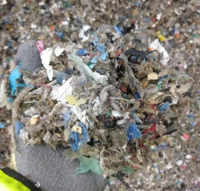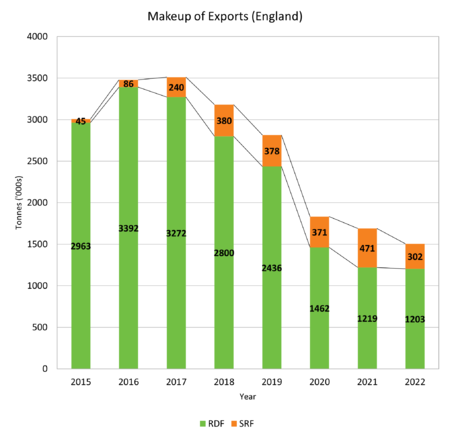Solid Recovered Fuel: Difference between revisions
m expanded text |
add page specific text |
||
| Line 1: | Line 1: | ||
[[Category:Tonnage & Waste Types]] | [[Category:Tonnage & Waste Types]] | ||
Solid Recovered Fuel (SRF) is distinct from [[RDF]] in that its quality as a fuel is far superior. It is typically used in processes that require a high quality, small particle size, high [[Calorific Value]], low [[Moisture Content]] material – such as | [[Solid Recovered Fuel]] ([[SRF]]) is distinct from [[Refuse Derived Fuel]] ([[RDF]]) in that its quality as a fuel is far superior. It is typically used in processes that require a high quality, small particle size, high [[Calorific Value]], low [[Moisture Content]] material – such as [[Cement Kilns]] and new-generation [[ATT]] plants. There is a move in the UK towards the production of pellets from [[SRF]] for subsequent use in industrial processes. | ||
[[File:Picture of SRF.png|200px|left|Picture of loose SRF, source Geminor all rights reserved]]__TOC__ | |||
<br clear='left/> | |||
Solid Recovered | ==Context== | ||
[[Solid Recovered Fuel]] ([[SRF]]) is distinct from [[Refuse Derived Fuel]] ([[RDF]]) in that its quality as a fuel is far superior. It is typically used in processes that require a high quality, small particle size, high [[Calorific Value]], low [[Moisture Content]] material – such as [[Cement Kilns]] and new-generation [[ATT]] plants. There is a move in the UK towards the production of pellets from [[SRF]] for subsequent use in industrial processes. | |||
Solid Recovered Fuels are covered by international technical specifications which set, amongst other parameters, the chemical and physical parameters of an [[SRF]] <ref>[https://www.iso.org/committee/5960430.html] ISO/TC 300 Solid Recovered Fuels </ref> | |||
==Composition of Solid Recovered Fuel== | |||
The composition of [[SRF]] is defined in the international specification set out above, but often an [[SRF]] in the UK can be a more refined [[RDF]] rather than something that complies entirely with the specification standard. The main chemical parameters that vary between an [[RDF]] and [[SRF]] mentioned above are broadly as follows: | |||
{| class="wikitable" | {| class="wikitable" | ||
|- | |- | ||
! Parameter !! [[RDF]] Example !! SRF Example | ! Parameter !! [[RDF]] Example !! [[SRF]] Example | ||
|- | |- | ||
| Net [[CV]] || 11 MJ/kg || 18 MJ/kg | | Net [[CV]] || 11 MJ/kg || 18 MJ/kg | ||
| Line 21: | Line 24: | ||
| Particle Size || 300mm || 40mm | | Particle Size || 300mm || 40mm | ||
|} | |} | ||
Chlorine is a particular issue due to its tendency to form [[wikipedia:Hydrochloric acid | Hydrochloric Acid]] in an energy recovery process, which then requires specific abatement/clean-up technologies. With limited such arrangements in [[Cement Kilns]] this means that they generally have a lower tolerance for Chlorine closer in a final specification [[RDF]] or [[SRF]]. In addition, the use of any [[Waste Derived Fuel]] in [[Cement Kilns]] has the potential to impact the final quality of the cement produced, and so the composition of an [[RDF]] or [[SRF]] is critical in the decision to use it in such an application in terms of the ash content of the [[RDF]]/[[SRF]]. | |||
==Export of Solid Recovered Fuel== | |||
Whilst the data reported for 2019 suggests in excess of 400,000 tonnes of [[RDF]] and [[SRF]] were used in [[Cement Kilns]] in the UK, there has been a growing and steady export market since 2014 for [[SRF]] into cement kilns. Whilst the export of [[SRF]] from the UK is often reported within the overall [[Waste Derived Fuel]]/[[RDF]] statistics, data for England alone from the [[EA]] shows a proportional growth in [[SRF]] export in the context of a reduction in [[RDF]], as shown in the graph below. | |||
[[File:RDF and SRF Export.png|450px|center|RDF and SRF Export - analysis of EA data by Monksleigh]] | |||
==Nascent [[SRF]] Pellet Market== | |||
Increasingly the market is considering further refinement (including reducing moisture and increasing [[NCV]]) of [[SRF]] to produce a high quality fuel pellet for ease of storage, haulage, and introduction into a [[Cement Kiln]], with some companies seeking to achieve [[End of Waste Criteria]] classification that would then enable the material to be used in other applications as a blended substitute for coal. There are three main organisations pursuing this approach in the UK market at the present time, each with a different 'brand name' for their pellet: | |||
===N+P (Subcoal®)=== | |||
[[N+P]] have been producing a pellet in their operation in the Netherlands and are in the process of producing their Subcoal®<ref>[https://www.np-recycling.nl/en/alternative-fuels/subcoal.html N+P website]</ref> pellets in their first plant in the UK in Teeside, with plans to expand to this at their recently acquired facility at Crayford<ref>[https://www.npgroup.com/blog/np-acquires-materials-recycling-facility-crayford N+P Press Release January 2022]</ref> | |||
===Waste Knot (SIRF Pellets)=== | |||
[[Waste Knot]]'s SIRF pellet<ref>[https://www.wasteknot-energy.com/product/#:~:text=SRF%20Pellets,Net%20Calorific%20Value%20of%20c Waste Knot SIRF Web page]</ref> is to be produced in their first plant, which is under construction in Middlesborough<ref>[https://www.wasteknot-energy.com/latest-news/ Waste Knot Website News Page]</ref> | |||
===Eco-PowerFuels (Eco Power Pellets)=== | |||
[[Eco-PowerFuels]] have been producing their Eco-Power Pellets in their facility in Humberside<ref>[http://www.eco-powerfuels.com/fuels/ Eco-PowerFuels Website]</ref> and in January 2021 was reported to have signed a contract to supply [[Tarmac]]'s [[Tunstead Cement Kiln]]<ref>[https://www.worldcement.com/europe-cis/22012021/tarmac-agrees-srf-pellet-deal-with-eco-power-environmental-group/ News Article from World Cement]</ref> | |||
==References== | ==References== | ||
<references /> | <references /> | ||
Revision as of 09:04, 4 March 2022
Solid Recovered Fuel (SRF) is distinct from Refuse Derived Fuel (RDF) in that its quality as a fuel is far superior. It is typically used in processes that require a high quality, small particle size, high Calorific Value, low Moisture Content material – such as Cement Kilns and new-generation ATT plants. There is a move in the UK towards the production of pellets from SRF for subsequent use in industrial processes.

Context
Solid Recovered Fuel (SRF) is distinct from Refuse Derived Fuel (RDF) in that its quality as a fuel is far superior. It is typically used in processes that require a high quality, small particle size, high Calorific Value, low Moisture Content material – such as Cement Kilns and new-generation ATT plants. There is a move in the UK towards the production of pellets from SRF for subsequent use in industrial processes.
Solid Recovered Fuels are covered by international technical specifications which set, amongst other parameters, the chemical and physical parameters of an SRF [1]
Composition of Solid Recovered Fuel
The composition of SRF is defined in the international specification set out above, but often an SRF in the UK can be a more refined RDF rather than something that complies entirely with the specification standard. The main chemical parameters that vary between an RDF and SRF mentioned above are broadly as follows:
| Parameter | RDF Example | SRF Example |
|---|---|---|
| Net CV | 11 MJ/kg | 18 MJ/kg |
| Moisture Content | 25% | 15% |
| Chlorine | <1% | <0.6% |
| Particle Size | 300mm | 40mm |
Chlorine is a particular issue due to its tendency to form Hydrochloric Acid in an energy recovery process, which then requires specific abatement/clean-up technologies. With limited such arrangements in Cement Kilns this means that they generally have a lower tolerance for Chlorine closer in a final specification RDF or SRF. In addition, the use of any Waste Derived Fuel in Cement Kilns has the potential to impact the final quality of the cement produced, and so the composition of an RDF or SRF is critical in the decision to use it in such an application in terms of the ash content of the RDF/SRF.
Export of Solid Recovered Fuel
Whilst the data reported for 2019 suggests in excess of 400,000 tonnes of RDF and SRF were used in Cement Kilns in the UK, there has been a growing and steady export market since 2014 for SRF into cement kilns. Whilst the export of SRF from the UK is often reported within the overall Waste Derived Fuel/RDF statistics, data for England alone from the EA shows a proportional growth in SRF export in the context of a reduction in RDF, as shown in the graph below.

Nascent SRF Pellet Market
Increasingly the market is considering further refinement (including reducing moisture and increasing NCV) of SRF to produce a high quality fuel pellet for ease of storage, haulage, and introduction into a Cement Kiln, with some companies seeking to achieve End of Waste Criteria classification that would then enable the material to be used in other applications as a blended substitute for coal. There are three main organisations pursuing this approach in the UK market at the present time, each with a different 'brand name' for their pellet:
N+P (Subcoal®)
N+P have been producing a pellet in their operation in the Netherlands and are in the process of producing their Subcoal®[2] pellets in their first plant in the UK in Teeside, with plans to expand to this at their recently acquired facility at Crayford[3]
Waste Knot (SIRF Pellets)
Waste Knot's SIRF pellet[4] is to be produced in their first plant, which is under construction in Middlesborough[5]
Eco-PowerFuels (Eco Power Pellets)
Eco-PowerFuels have been producing their Eco-Power Pellets in their facility in Humberside[6] and in January 2021 was reported to have signed a contract to supply Tarmac's Tunstead Cement Kiln[7]
References
- ↑ [1] ISO/TC 300 Solid Recovered Fuels
- ↑ N+P website
- ↑ N+P Press Release January 2022
- ↑ Waste Knot SIRF Web page
- ↑ Waste Knot Website News Page
- ↑ Eco-PowerFuels Website
- ↑ News Article from World Cement
